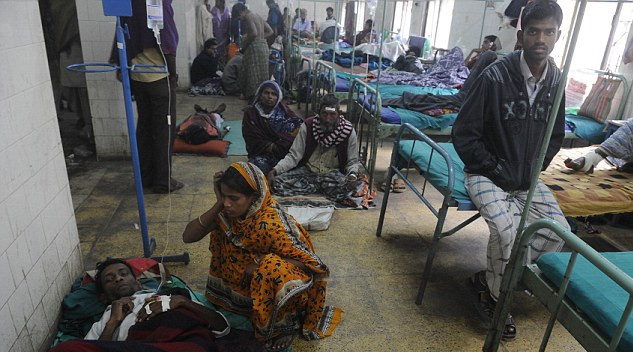Doctors and nurses are not in position, sub standard medicines are being doled out, patients are crowded on beds and floors, and many ICUs have no equipment.
The government run healthcare system in Gujarat has deteriorated to an alarming extent with up to 77% specialist doctors and 69% general doctors not in position, shortage of nurses up to 72%, and paramedical staff up to 41%, shortage of beds in hospitals up to 73%, funds for buying medicines lying unutilised, essential drugs in short supply, patients being given medicines that are already declared Not of Standard Quality (NSQ) and accident and emergency services either not available or partially available.
This emerges from a chilling account given by none other than the Comptroller and Auditor General (CAG) in its report submitted in 2016 covering the period 2010-2015. Despite being a rich state with high levels of industrialisation and agricultural output the Gujarat Model, as it is repeatedly described by Prime Minister Modi, seems to have comprehensively failed to care for the most basic needs of Gujarati people. The near collapse of the public healthcare system has not only resulted in worsening health indicators but also pushed up medical costs of families by pushing them into the greedy arms of private hospitals and doctors. Of particular note is that many of the tribal districts were found by the CAG to have shockingly bad facilities, worse than other districts.
As of March 2015, the health needs of the people of Gujarat were being catered to by the State Government through 34 District level Hospitals (DH), 42 sub-DHs and 321 Community Health Centres (CHCs) at taluka level and 1,265 Primary Health Centres (PHCs) and 8,121 Sub-Centres (SCs) at village level. The CAG team test checked 8 district.
The shortfall in the cadres of Specialist Doctors ranged between 29 and 77 per cent, and that of Medical Officers ranged between seven and 69 per cent vis-a-vis Indian Public Health (IPH) Standards. The situation was reported as “alarming in DH Surendranagar, DH Godhra, DH Petlad and DH Vadodara where shortage in the cadre of Specialist Doctors was more than 60 per cent”.Similarly, vacancies in the cadres of staff nurses ranged between seven and 72 per cent, and para-medical & other staff ranged between 31 and 89 per cent vis-a-vis IPH Standards.
Out of 13,833 beds available in district level hospitals, 10,645 beds were available in 11 districts to cater to a population of 3.55 crore(23% of state population) and only 3,188 beds were available in remaining 22 districts to cater to a population of 2.49 crore (41%). The CAG team reported “instances of highly congested wards and patients lying on the floor; two patients were accommodated on one bed for transfusion of iron sucrose, and patients accommodated in the passageway due to non-availability of vacant beds”.The state govt. had Rs.732.64 crore for building healthcare infrastructure during 2010-15, but it spent only Rs.580.08 crore (79%) till March 2015, as per CAG.
Number of essential drugs (EDs) viz. Amoxycilin, Diclofenac Sodium, HepatitisB Vaccine, Injection Ceftazimide, Insulin, etc. were not available in the stock for more than four months in all test-checked hospitals. According to the CAG, as of August 2015 12 to 76% of EDs indented by the test-checked hospitals were not available for more than four months and “consequently the patients were forced to purchase medicines from the open market”.
The hospital authorities attributed the reasons for stock-out of medicines due to delay in supply of medicines by Gujarat Medical Services Corporation Limited (GMSCL) and stated that essential medicines for IPD were being purchased by the hospitals locally, in case of need. GMSCL was created in 2012 by the govt. after closing down the Central Medical Stores Organisation (CMSO), which was a govt. department. Since then, GMSCL’s fund utilisation has slipped from 86% in 2012-13 to just 55% in 2014-15, although funds available to it have tripled in this period. GMSCL surrendered unutilised funds of Rs.47 crore in 2014-15.
In the test checked hospitals, the CAG found that GMSCL was supplying Not of Standard Quality (NSQ) medicines and these were being given to patients with abandon. They found that out of 399 NSQ batches, 221 had been consumed by patients.
“Accident, Emergency and Trauma care services were either not available or were not equipped with essential equipment in test-checked DHs,” the CAG Report noted.
Intensive Care Units (ICU) were not available in three out of seven test-checked DHs. In the remaining four DHs, the shortage of beds ranged from 38 to 80 per cent and only one or two beds were fully equipped with life saving equipment to handle critical cases. The position was also very deplorable even in Civil Hospitals, as only five out of 11 beds and nine out of 36 beds in CH Bhavnagar and CH Vadodara respectively were fully equipped with life saving equipment.
High newborn and maternal deaths were recorded by the CAG in several hospitals because of “vacant posts of Gynaecologists and Paediatricians, and lack of life saving equipment and beds in the maternity ward”.
They also recorded that equipment for conducting various tests were not available in the diagnosis and imaging departments in test-checked DHs. Blood bank/blood storage centres were either not established or remained non-functional in test-checked DHs except in DH Godhra, DH Surendranagar and DH Himatnagar.
Courtesy: Newsclick.in

